Annie Sloan Chalk Paint: China Hutch Makeover
This post may contain affiliate links which won't change your price but will share some commission. Read more here.You don’t have to be a professional painter to learn how to chalk paint furniture! This china hutch makeover used Annie Sloan chalk paint and turned an outdated piece of furniture into a shabby chic beauty!
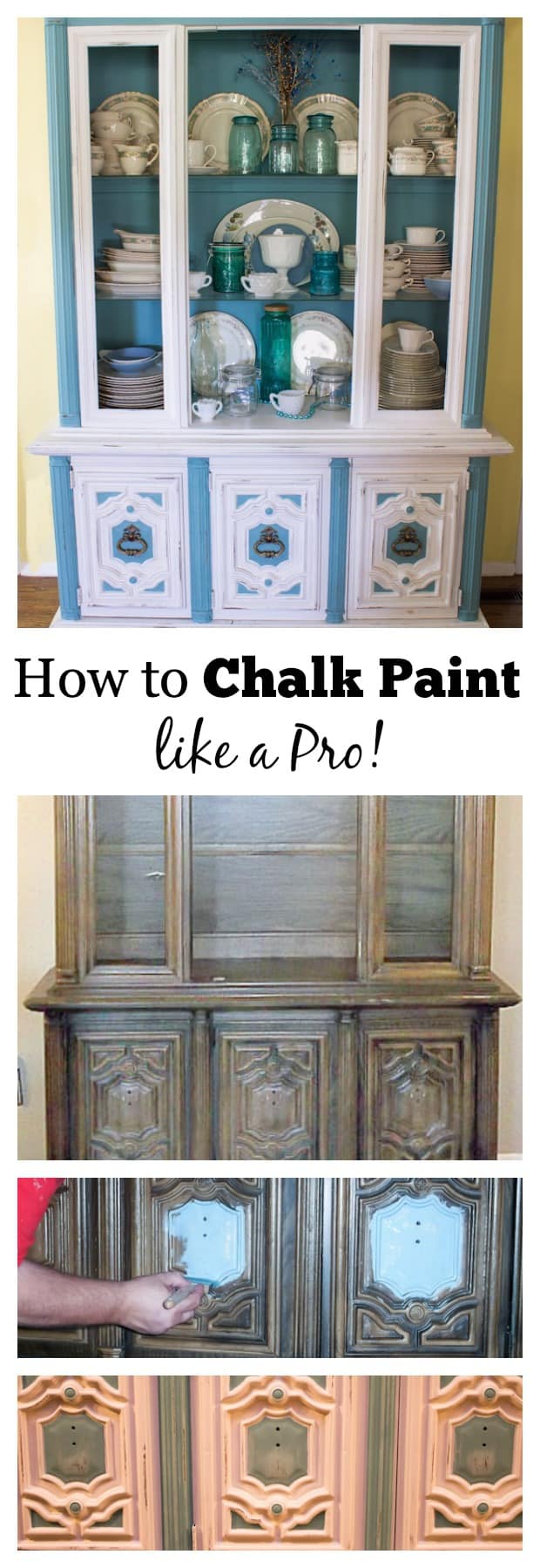
We now have a major love of chalk painting as seen in our mason jar chandelier, small kitchen buffet and this amazing china hutch makeover. (Since we’re more experienced in chalk painting you can read everything we’ve learned in 7 Chalk Painting Tips for Beginners.)
When my parents moved into a nursing home I became the recipient of my mom’s china hutch, circa 1970’s.
I remember the day it arrived at my childhood home so many years ago. My parents were not wealthy and barely scraped by most of the time. Yet my dad often found a way to buy the things my mom most desired. In the 1970’s that was a place to showcase her china and crystal, beautiful gifts from my parents’ wedding in 1945.
I can’t say I always wanted the hutch, but I knew one day I would inherit her china and crystal.
This bulky piece has been an eyesore in our kitchen. It was out of place and just didn’t fit. As I became addicted to Pinterest I started seeing chalk paint pieces that I loved and the search was on to find the right product and convince my husband to try it.
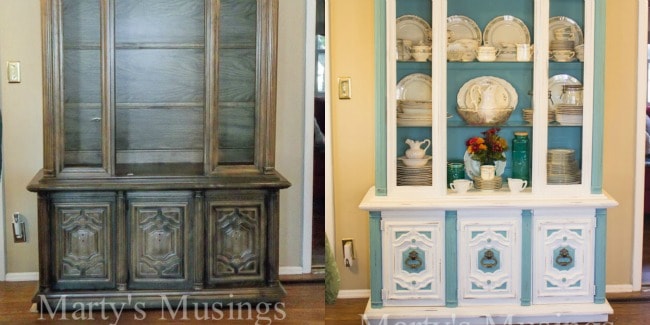
I started by telling him my ideas and sending him pictures of projects I liked. I knew the day he sent ME a picture that I had ensnared him in my sneaky plan!
He is a painter after all, but I was willing to try to do the painting myself. As we got closer and closer to actually purchasing the paint Tim began to take ownership of the project. Yes, I succeeded in my dastardly plot to get him to do the work after all!
Here’s the china hutch in its original position in our kitchen, with glass and door intact.
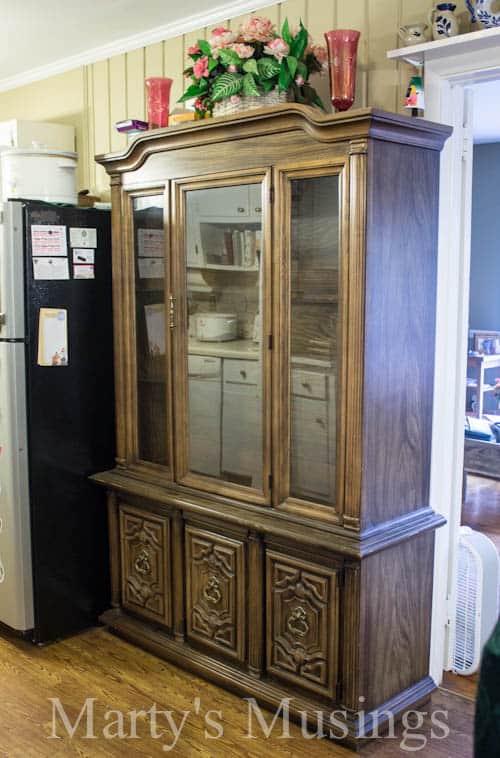
Now moved to the opposite wall, destined to become the showpiece of the room.
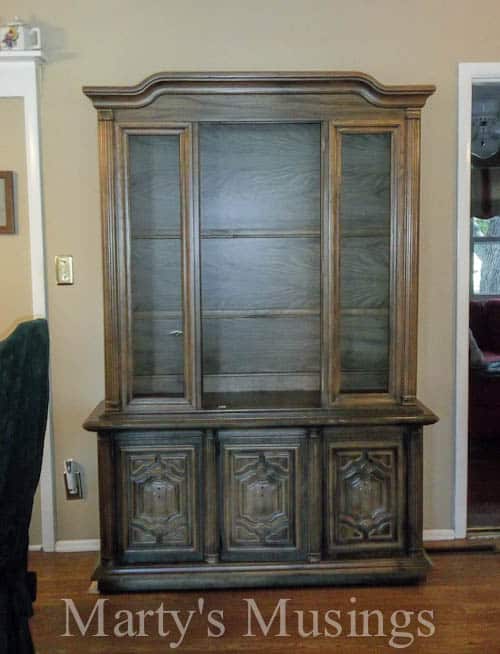
Door and windows now removed. The wood is that gross ’70’s kind of pecan walnut something. Very dark and scary…
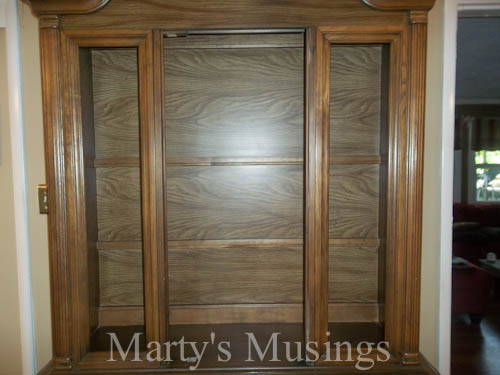
Enjoy as my husband tells you all the details.

Annie Sloan Chalk Paint Tutorial
From Tim: OK – so this is where I take over the post…the hubby! This china hutch makeover was a “surprise” for my wife when she returned from a few days out with her friends.
The kids were gone, too, so I had the entire weekend to myself! THAT’s the look on my face! My house was SO quiet that I thought I was on the wrong side of the Rapture…left behind with chalk paint and an u-g-l-y hutch to transform. Yuck. But I digress.
Preparation
You must first know that working with Annie Sloan chalk paint goes against EVERYTHING I have learned in 22 years in the painting business.
The ladies at the business we bought the paint from, upon learning I was a contractor, told my wife that I was “NOT to make it perfect.” Strike one. All the instructions also said do not do perfect brush stroke applications, but criss-cross sloppy instead. Strike two.
The last straw was their recommendation to use a natural bristle brush with chalk paint. Problem? Absolutely! Natural bristle brushes are for use only with oil based paints, stains, and polyurethanes. One does NOT introduce these brushes to water, ever. Guess what? Chalk paint is water based, so you clean the brush with – say it with me – WATER! STEE-RIKE THREE!
Painting
I totally bailed at this point, despite the chief’s my bride’s protestations. So, I began with the inside to avoid working on top of wet paint on the outside and dove into the blue. Not pretty, not straight lines, criss cross. Ugh…it’s gonna be a long weekend.
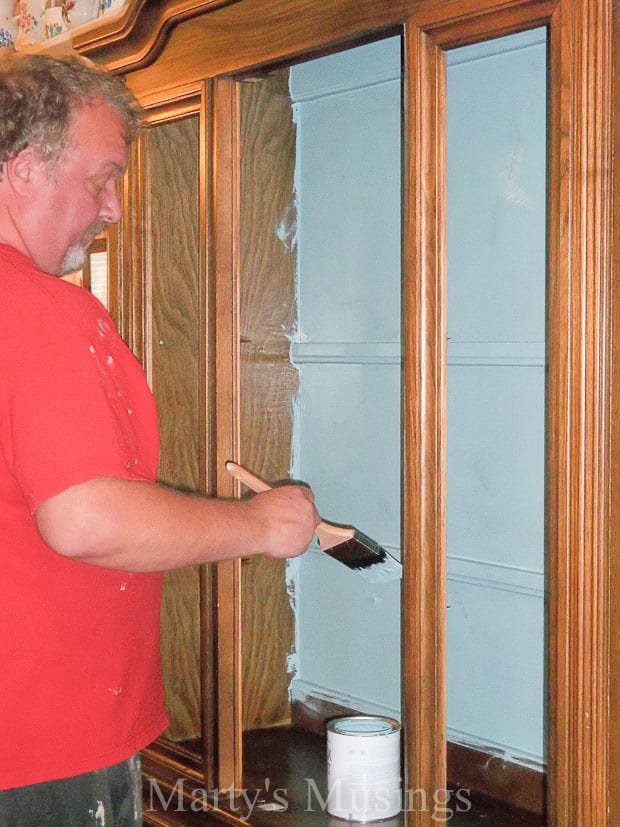
With the glare of the camera flash, you can pick up a little of the haphazard brush strokes. It really did make a difference when it came time for waxing; the variation in the surface enhanced the effect and would have been even more pronounced had I used the dark wax (we used clear).
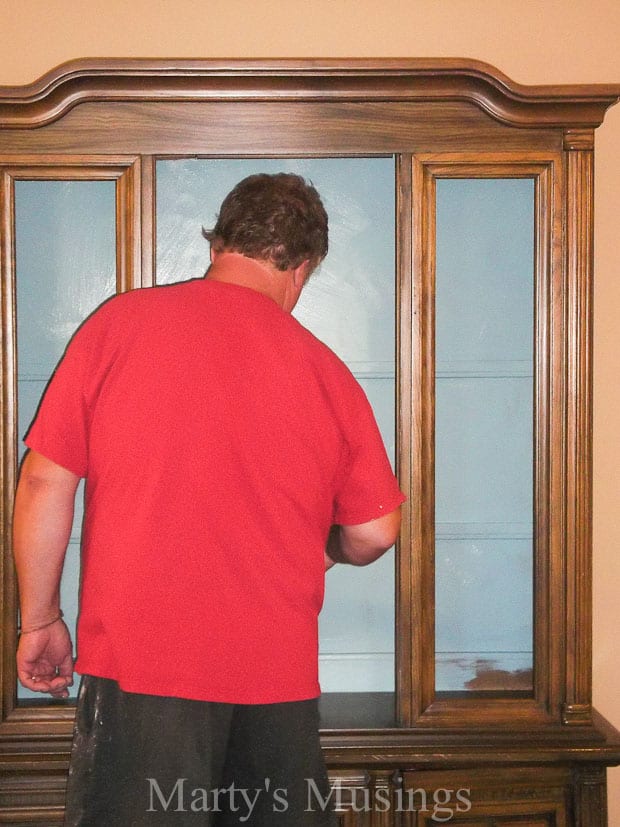
While I knew I wanted the back blue, I had no idea what to do on the rest of the outside.
The piece had some beautifully intricate detail work, but I didn’t want to over-accentuate all of it and end up with a circus tent. I also knew that I could fix whatever became too garish with a re-coat of the other color. So, the best option was just to muddle forward and see what happened.
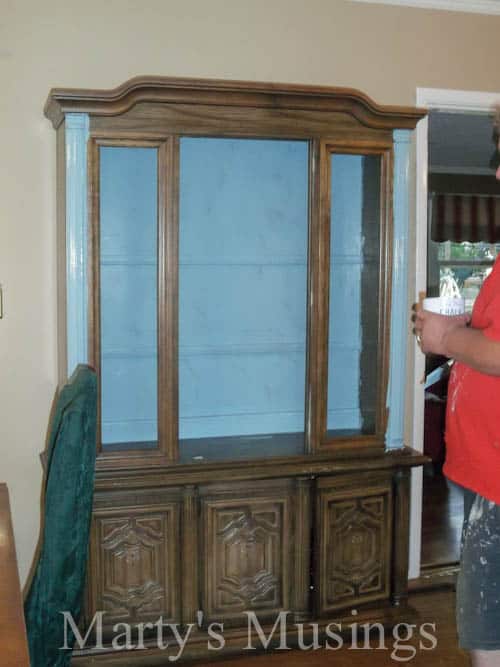
Beginning to take shape now, and will you look at those brush strokes! I’m still cringing. You can see that the doors have tremendous potential, but that is some pretty fine detail work and I kept thinking that it would be so easy to do too much on those. However, by the end, I would take advantage of most of that detail.
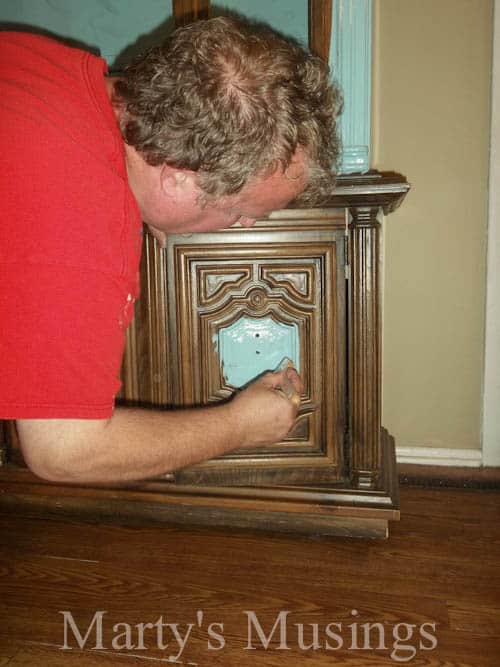
One of the unique features of Annie Sloan chalk paint(and all chalk paint in general) is that no priming is required. That was a VERY close strike four for me! I think one of the biggest deterrents to painting furniture that people have is that awful, smelly, messy, tedious step of an oil based primer before you really make progress.
With chalk paint, you jump right in and are transforming immediately. You are only limited by what you cannot imagine, and even at this point, I decided to go a bit further with the details.
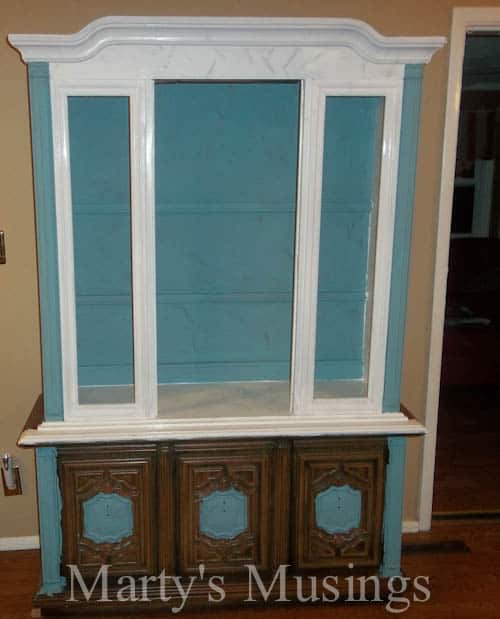
Distressing
See! It really grows on you. This is almost finished, with two coats of each color everywhere.
You can also pick up some of the distressing that I did, but even that continues to this day. The scuffs are achieved by simply going after the surface with some heavy grit sandpaper (60 grit!). If you find you’ve done too much, just re-coat and start over. Your mistake may actually shine through a bit and add to the desired look.
Some of the videos suggest putting Vaseline on the areas where you are going to distress before you start painting. Because Vaseline is petroleum based, it does not react with water, thereby rejecting the water based paint. It, in theory, wipes right off.
Not for me – I knew had a 60 grit weapon in the wings! Plus, that sounded like far too much planning.
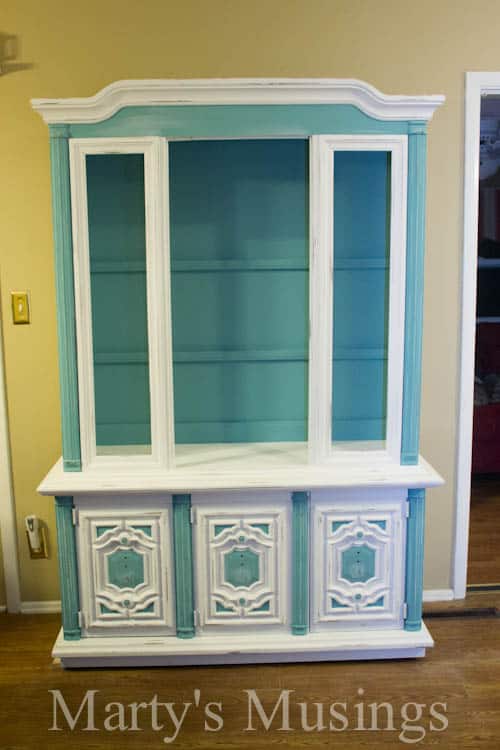
A few close-ups of the doors for detail and distressing. Until I painted the doors, I never paid any attention to the details. Well, honestly, I always averted my eyes away from the hutch every time I walked by, but that’s for another day.
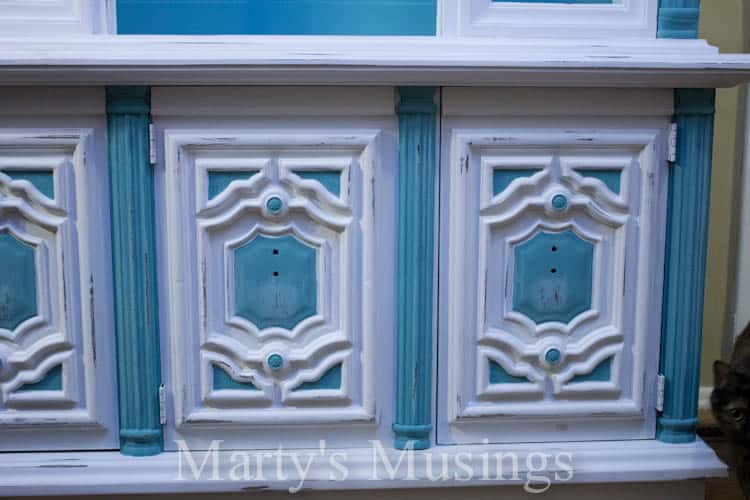
There are big honkin’ handles that go back on that are the door knocker style, so it made sense to distress where they naturally hang. You also get a little better idea of the distressing.
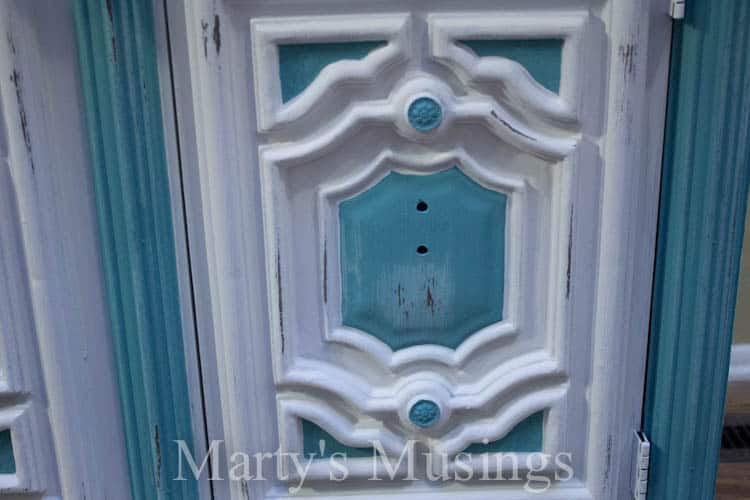
Waxing
The cavalry has arrived! I enlisted helpers to apply the clear wax, since you really can’t do this part wrong. It is “wax on – wax off.” Just a light coat really draws out some of the brush strokes, the variations in the surface and the darker distressed spots.
A dark wax would make a huge difference, but I wasn’t bold enough to go there.
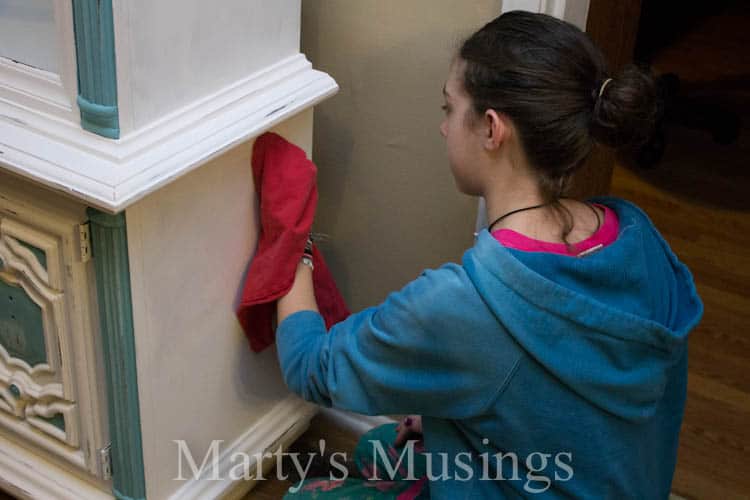
Trust me, it’s not THAT blue! But it does change with the amount of light that enters the room.
(From Marty: sorry about the color changes in photos. We shot at all different times of day and I had trouble editing the shots to all reflect the same color. But Tim is right, the color changes somewhat as you place other objects around it.)
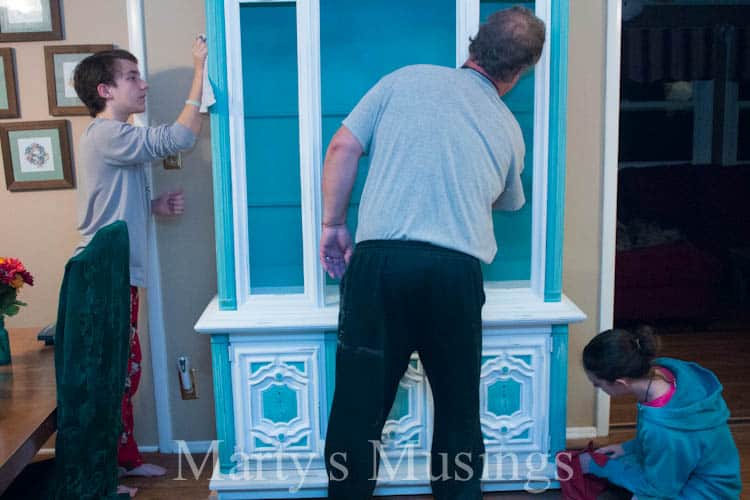
And yes, by this point, I was quite ready to be done with the transformation.
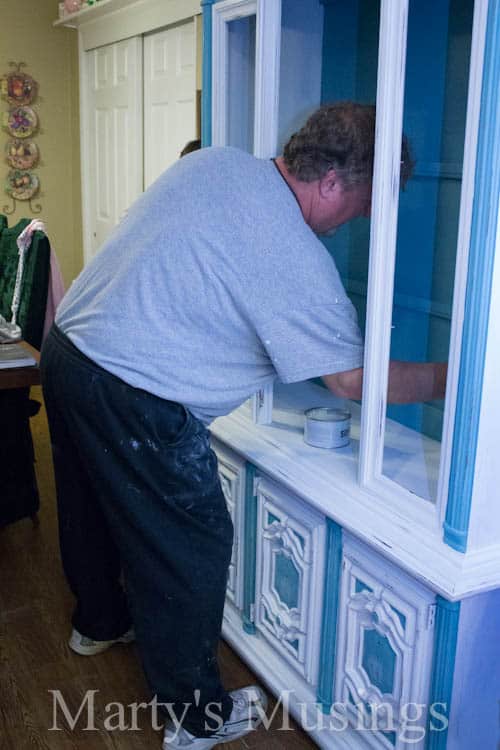
Want to ruin a brush, even a synthetic bristle brush, in one easy step? Use it to apply wax! This was a great way to get into the harder areas, but there was no getting the wax completely out of the bristles, even with boiling water. It’s now my waxing brush – go figure.
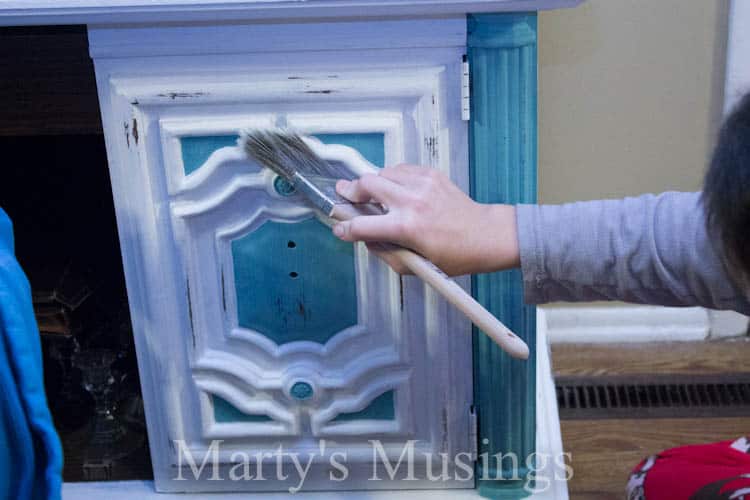
Here is a final view of a finished door. See where the handle hangs right where I distressed? Your distressing, while random, should still make sense. Unless you’ve bounced the furniture down your front steps or thrown it off the moving truck, it probably isn’t scratched everywhere.
We’re still not sure about the color of the handles, but we need to live with it for a bit before making a change, if any.
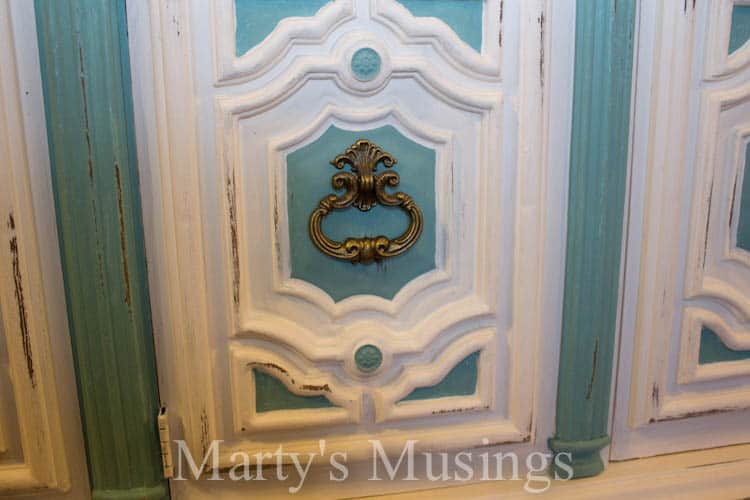
Less the handles, this is finished! Total time was about 5 hours, I think.
By the way, buying this brand of chalk paint is EXPENSIVE! At $40 a quart, a gallon would run $160! Strike five, six, seven, eight, and nine! That’s the inning. That’s the ballgame.
But it really transformed this behemoth into a conversation piece. FYI, we’re pretty sure the walls need to change to a pale yellow.
So, go for it! If I get advanced Rapture notice, I’ll race you to get more chalk paint! Not that I’m saying either one of us won’t be leaving…
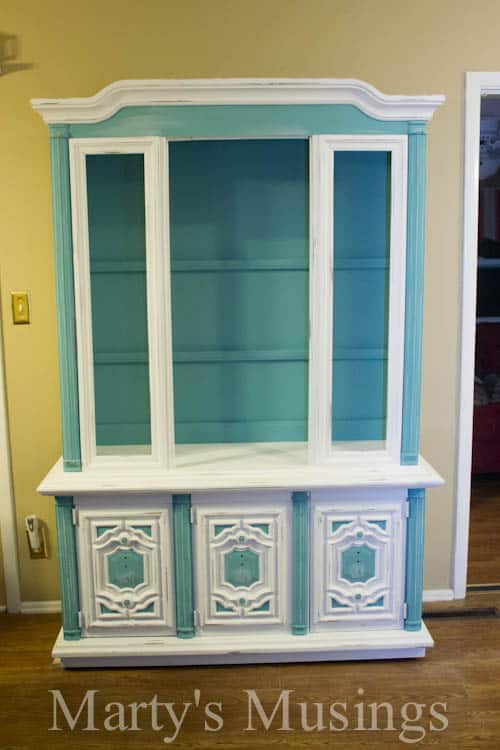
From Marty: this post is just typical of our relationship. He’s the funny guy and I’m the sentimental one.
I set the mood with a nostalgic look at the china hutch makeover and he’s cracking jokes left and right and comparing the chalk paint to a baseball game! What can I say?
We’ve made it 25 years and I guess we have a few more good ones ahead (at least as long as he keeps tackling my projects like the scrapbook room remodel, the den makeover , mason jar chandelier and his amazing window table.)
**The paint used in this project is Annie Sloan chalk paint, Provence and Pure White, with clear wax applied over the top.
***Here you can see we’ve updated this piece with Pure White over the entire hutch. Love it!
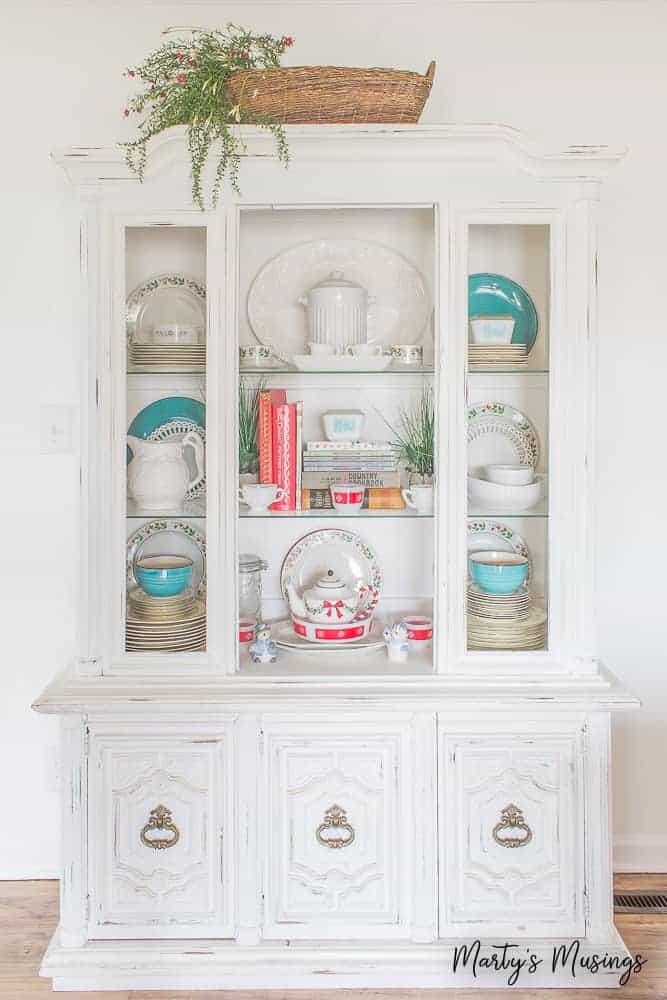
More Chalk Paint Ideas
Practical painting tips for the home that anyone can use, including chalk painting, accent walls and choosing the right colors.
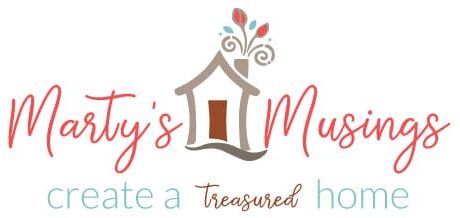

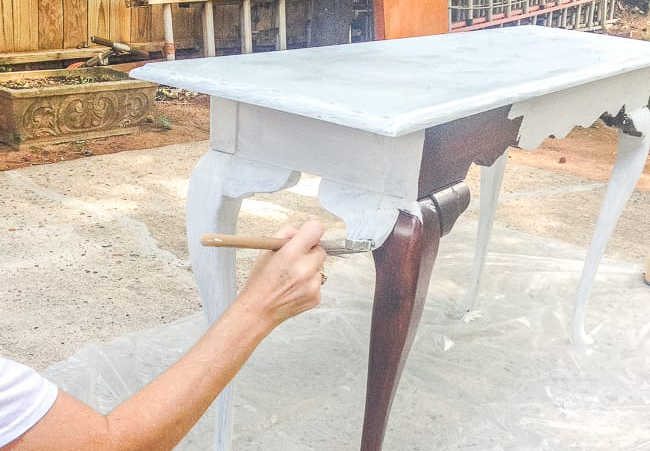
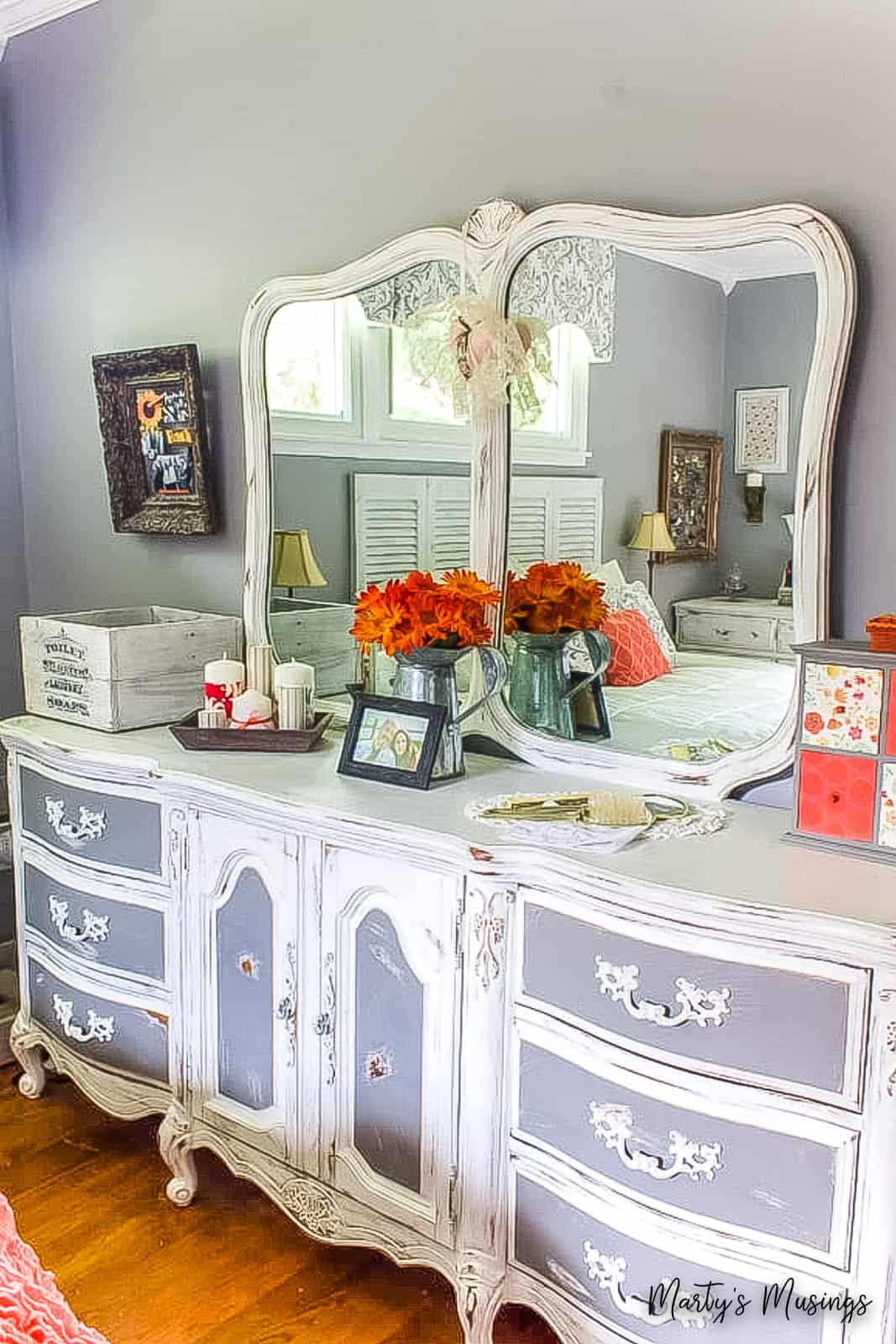
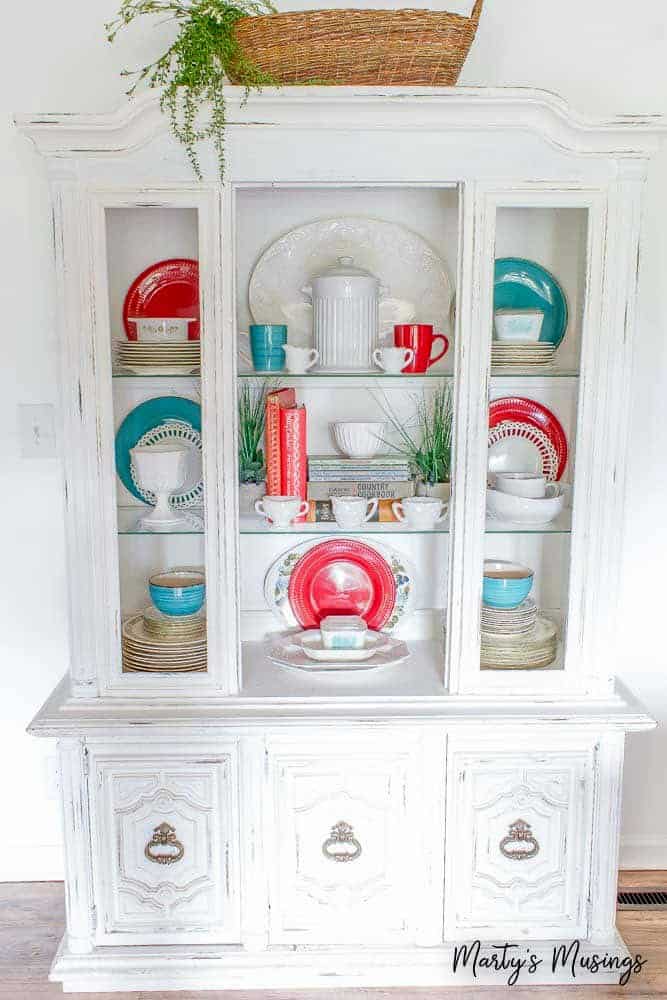
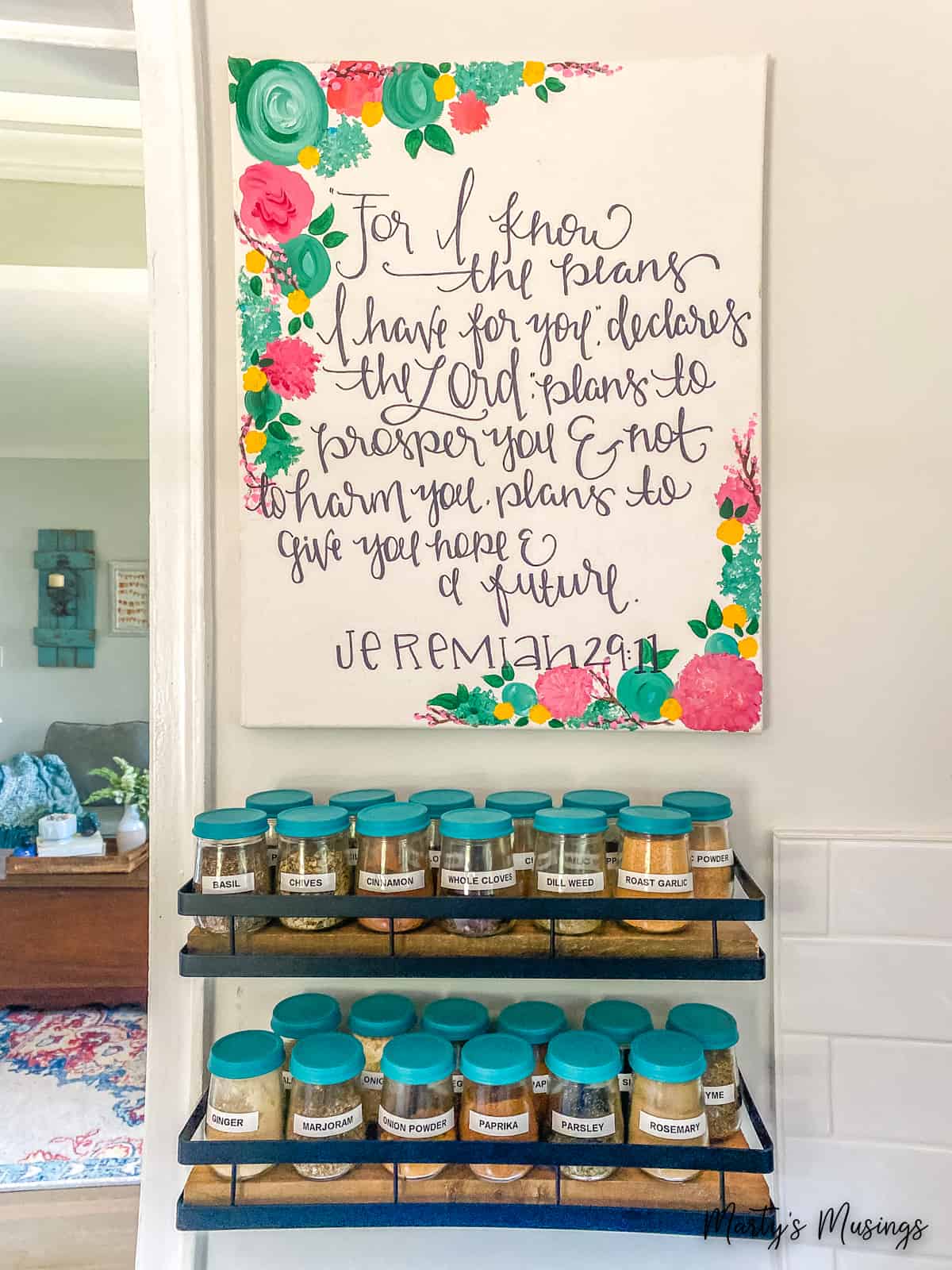
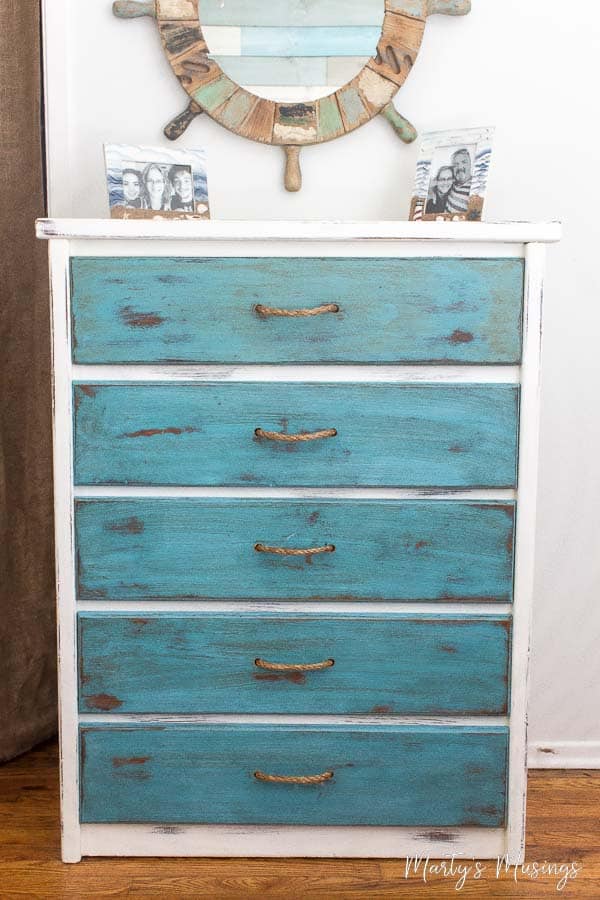

You have learned in 22 years in the painting business! Wow, Unbelievable. I will have to learn from you so many things about paint.
I need to ask a question. I am going to paint my table and chairs with chalk paint. I do not want a rustic look, can I just paint and not wax and them still hold the paint?
Hi, Pat. Here’s my husband’s response: I would not recommend that you leave the chalk paint unsealed in some way. It simply will not hold up to the traffic your use demands. Chalk paint really grabs dirt, stains, spills and general nicks and scratches. It will also not clean well, which will be important for the table. Over time, the pieces will naturally distress and morph into a look you are not going for.
If you don’t want to wax, you might consider an oil-based polyurethane in a flat or satin finish. This will seal the pieces and work to maintain the finish you desire. Do NOT use a water-based poly as this will re-activate the paint (water-to-water reaction). This will also allow you to touch up as needed and re-seal with the poly. I was shocked at how much dirt and abuse our table showed, so much so that I actually re-painted the top of the table with a Rustoleum oil-based product with a semi-gloss finish. Very hard finish and quite easy to keep clean, plus I can re-do it any time. However, be aware that oil-based products will yellow over time, and faster in the absence of light.
Good Luck!
The hutch is exactly like ours.. thank you for featuring it. In addition, my mother had the same china (on the top shelf) and now my sister has it. A friend at a distressed furniture store has suggested mirrors fitted onto the back to bring a bright look on the china. What do you think? I like the idea.
Hi, Denise. That’s an interesting idea with the mirrors. It might be a little pricy but you could check it out. This particular hutch had a light that illuminated the inside from the top but I’ve never used it. That might be another idea. Good luck and send me a picture when you finish it!
I am just learning about chalk paint and am excited to try it on a garden stool that I have had for a couple of years. I have never been happy with the white color. I suppose it is ceramic and it has lots of cutwork on the sides. Will ASCP work on this type of surface? Will the steps be the same as with a wood project?
Hi, Mary. Here’s my husband’s response: The “ceramic” description concerns me a bit, but you could test the ASCP on the under side or somewhere else, let it dry and give it a test scrape to see if it will hold up. Depending on that result and how much traffic the stool would get, you can proceed as normal or prime it with an oil-based primer first (must be oil).
As for the process it will, indeed, be the same as wood. Don’t worry about perfection, but you don’t want drips. You’ll need to watch that with the surfaces that are more dimensional (cut surfaces). If you are going to distress do that before you wax and you’re done!
Have Fun!
There are many good ideas in this blog. I read everything carefully because I want to paint a wood table and 4 chairs. I’m not sure about the color, I am afraid that will look worst than now. I want to use this table in the garden this summer.
Hi Jeff. Thanks for commenting. Good to know about the outdoors application although I can’t imagine it on a driveway! Good tip for the wax brush as well. Thanks!
Sounds like you could use a Chalk Paint class-I had to unlearn everything or wipe my slate clean to believe how simple this paint was(is!). It’s a good cheap investment and you’ll learn and master 5-9 techniques to be able to jump right in and hit grand slams. Girly paint yes, but I like it too.
Hi, Faye. Our hutch is solid wood but I think the chalk paint would be fine even on the pressed board. You could always test a piece that doesn’t show, possibly the back and see how it does. Good luck!
Hi, Caco. Good luck on your house. Painting everything sure takes time and patience, as you said!
Just found this blog. Was searching for chalk paint. Great post and site! I also love that the hubby calls his wife, his bride. After 28 years, my husband calls me his bride too.
Thanks so much, Myra! How sweet that your husband calls your his bride. It’s a great term of endearment.
Love the bantering back and forth between you and hubby….we have the same thing going on at our house but for some reason I end up doing the work and he ends up telling me what I am doing wrong…go figure. Anyway I love the hutch would never had thought the transformation of that old 70’s piece could come out so pleasing to the eye. I am looking for an old window so I can do one like yours, love the picture in multiple panes makes it unique to what I have seen around here. Great job, good work and I will be following you closely. 🙂
Thanks, Marianne. Trust me. We have our anxious moments and “discussions” over how things turn out. I’ve just learned to chalk paint so I’m afraid I’m going to have to do more of it myself! I’m glad you’ll be following along!
Love it, I just did a kitchen hutch in my house over in black but I didn’t use chalk paint just ordinary latex paint from Loews, I distressed it with sandpaper and used clear wax which to me was the hardest part of doing this project. I could only find clear wax where would you get dark colored wax? I now want to do my dinning room set which was my grandparents its ugly and dated back to 1960, my night stand another hand me down, and about 5 other pieces of furniture. Whats the difference between chalk pain and latext? Cheers!!
Hi, Joya. Here’s some info from my hubby: Chalk paint and latex paint are both water-based. The major difference is the bonding property of the chalk paint; it is designed to skip the priming step that latex paint requires in order to bond to the surface. There is a relatively new product available at Home Depot and it’s DecoArt Americana Chalky Paint in a whole array of colors. They include 3 different wax finishes. I’ve only used them for a home decor project but I believe the cost is less than the Annie Sloan chalk paint. Good luck!
Hi there 🙂
I love that colors on this beautiful piece of furniture !!!
I painted my whole kitchen cabinets with chalk paint and everybody love it …
One advice regarding cleaning waxed brush – you have to clean it with mineral spirits 🙂
Just pour a little bit of it into a glass container , dip your brush, stir and leave for a couple of hours than wash under the water and it’s done 🙂
With love,
Kinga
Hi, Kinga! You are so brave to paint your kitchen cabinets with chalk paint. I love the look, but I also know the paint is expensive. Thanks for the tip and for visiting my blog!
Can you use chalk paint on outdoor furniture? Do you use a clear coat to protect it?
Hi, Randy! Here’s my husband’s response: I have seen chalk paint used on surfaces and projects I would never consider doing, but I am no expert on chalk paint! My gut reaction is that protecting it with a heavy-duty polyurethane, like Minwax’s Spar Urethane, would preserve the paint. However, normal traffic, use, and weather will mandate a re-coat now and then. To be safe, you might contact whoever you purchase your chalk paint from and ask their advice.
I was amazed to see the color scheme in your house! That’s exactly what I have begun to do in my new home. Is there any way I could know the exact name of that yellow color on your dining room walls? Lowes or Home Depot? I would like something very similar to that. Your home is beautiful and so inspiring! I have a hutch that I’ve had since I was a child that needs major restoration ! I have now liked your page on Facebook and look forward to seeing more of what you do. Thank you so much
Hi, Leigh. The color yellow we used is actually a Duron paint color and it’s Yellow Begonia, 7242W. Thanks for following along!